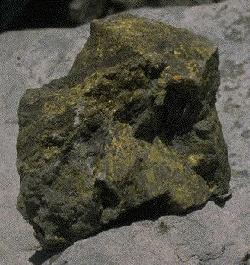
Published on the World Wide Web, August 25, 1997
Edited by Charles H. Bucknam
The development of the NCV method for acid-base accounting was brought about by new mining regulations in the State of Nevada in 1990. A lot of semi-quantitative mineralogic information (XRD-XRF) was available on the Carlin trend gold deposits, including percentages of carbonate and sulfide minerals, which were used to initiate the studies. Percent carbon dioxide (%CO2) was selected as the common unit for balancing the acid neutralization potential (ANP) of the limestone hosted deposits, against the acid generation potential (AGP) due to the sulfides present.
ANP was calculated based on 44% CO2 in calcite, 48% in dolomite, 44% in ankerite and 38% in siderite. AGP was calculated based on stoichiometric equivalents of one sulfide being oxidized to sulfuric acid, consuming one carbon dioxide, with a factor of -1.37 times the percentage of sulfide. Sulfide minerals present in the samples included 53% sulfide in pyrite and 20% sulfide in arsenopyrite. The overall stoichiometric equation is as follows:
NCV = 0.44 * calcite + 0.48 * dolomite + 0.44 * ankerite + 0.38 * siderite -1.37 * 0.53 * pyrite -1.37 * 0.20 arsenopyrite, %CO2
Drill hole composites were classified into ranges of NCV and plotted on cross sections through the deposits, with negative NCV zones (representing acid generation potential) being contoured in red. Composites representing waste in 20' mine benches were prepared and submitted for carbonate and sulfide by combustion-infrared absorption spectrophotometry analyses using industry standard metallurgical assay methods for Carlin ores:
ANP is calculated by the difference between total carbon and residual carbon after hydrochloric acid digestion and the result is converted to %CO2 units using the factor of 3.67. AGP is calculated by the difference between total sulfur a residual sulfur after pyrolysis and the result is converted to %CO2 units using the factor of -1.37. NCV is calculated by adding ANP and AGP. The overall equations are as follows:
After the initial characterization of the historical deposits, the use of combustion-infrared analyses became the routine method for waste characterization during active mining and for evaluation of new projects. The use of XRD-XRF analyses continues to play an important role, in interpretation of the NCV results, even though it is less sensitive than the combustion-infrared methods. Mineralogic ANP and AGP estimates are compared with combustion-infrared NCV results for quality assurance during characterization of new deposits, to check for method bias.
ANP results are also plotted against -AGP results in a scatter plot and a histogram of NCV values is made for each geological waste type in each deposit. Results are interpreted using the following general classification scheme:
Representative samples of core are selected for each or the major geological waste-NCV classifications (> 5%) for further testing, called confirmation tests. Typically, at least one hundred bench waste composites are tested for NCV during the initial characterization program and 10-12 select core samples are used for the follow-up confirmation testing.
Testing of these type samples usually includes NCV analyses, XRD-XRF, other acid-base accounting tests, such as ANP titrations, etc., BC confirmation tests or biological acid production potential (BAPP), meteoric water mobility procedure testing ( MWMP), or synthetic precipitation leaching procedure (SPLP) testing and possibly humidity cell testing, if necessary. Results are used to recommend a routine testing method to be used during the operation of the mine.
Conversion from CO2 to CaCO3 may be accomplish by dividing by the 0.44 factor.
Run-of -mine site column testing is probably the best alternative for kinetic testing studies during the life of the mine. Test materials from the geological waste-NCV type confirmation tests may be selected to cover the range of materials to be encountered during waste disposal operations. Several tons of each test material are sampled and one representative half placed in an open tank for exposure to rain fall and the effluent collected and periodically analyzed. The other half of the sample needs to be thoroughly characterized, since these are long-term tests. Mine operators may infer from the test results, the worst case of what may be happening inside the waste dumps with similar materials.
Return to: